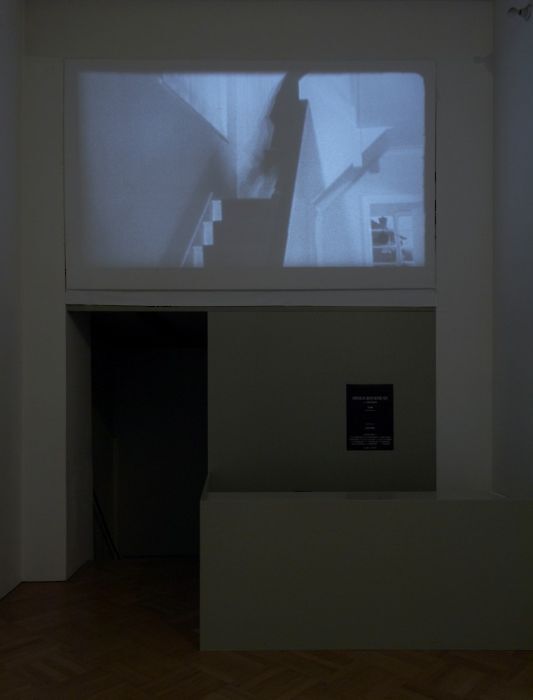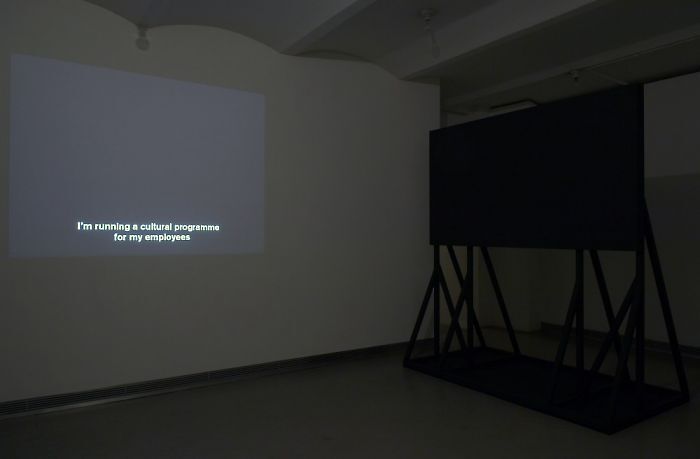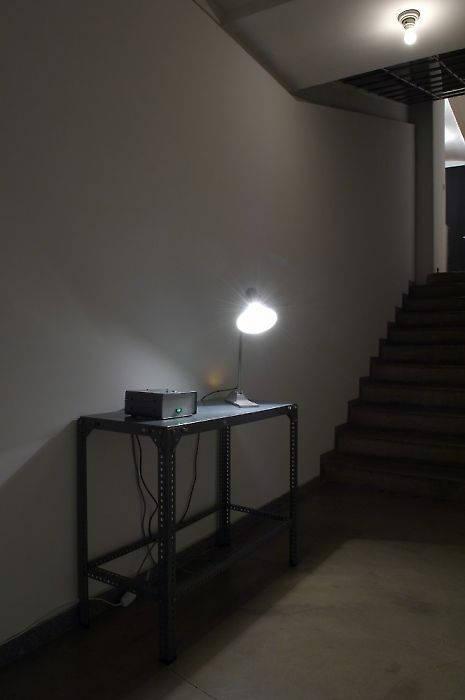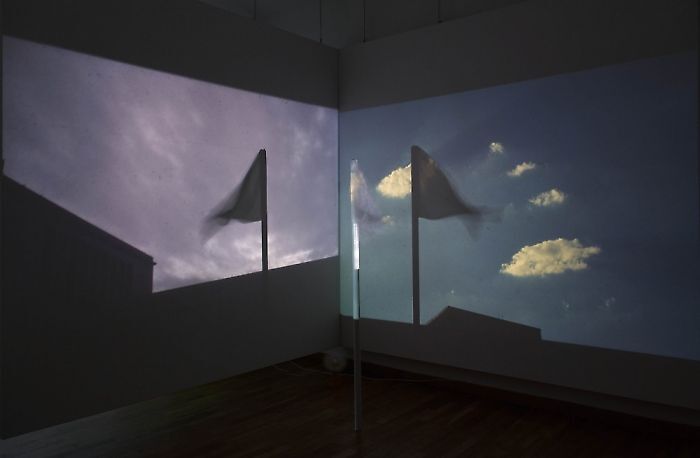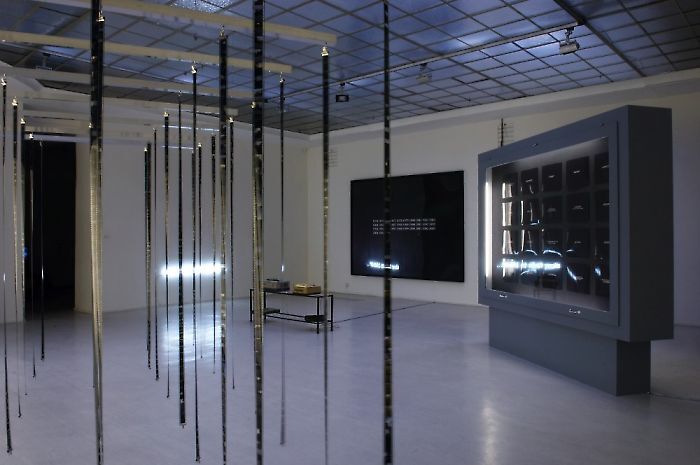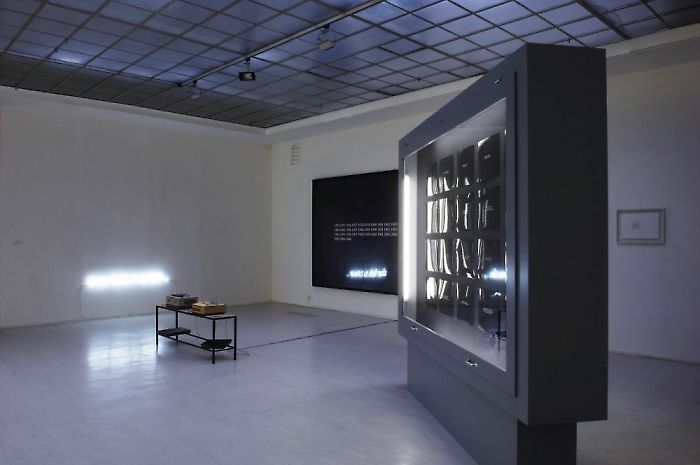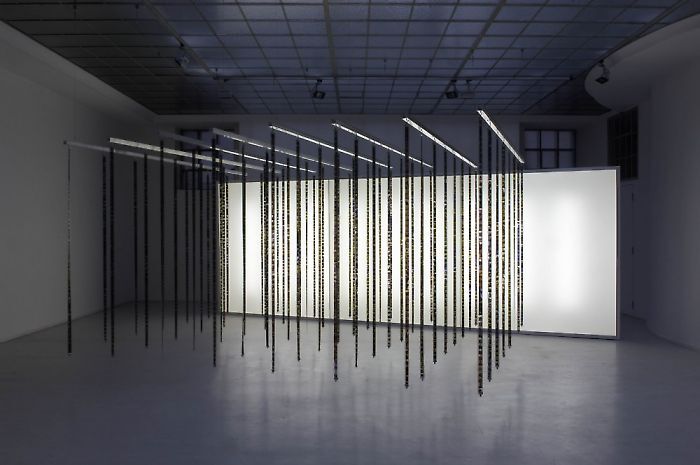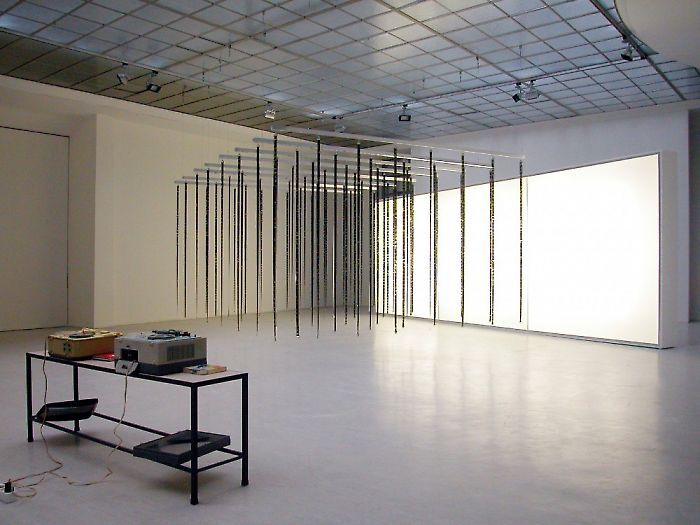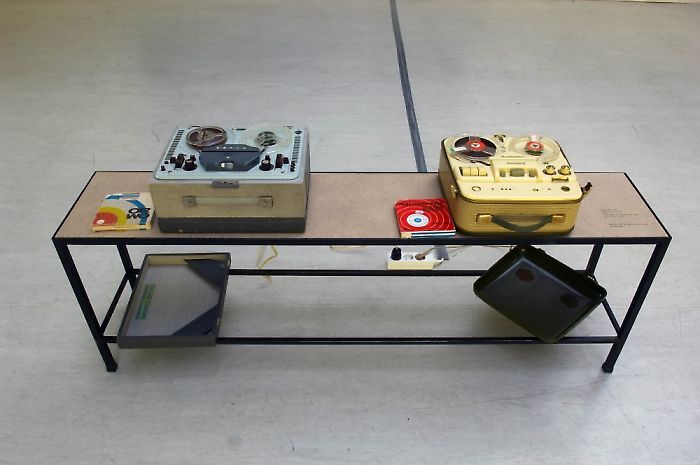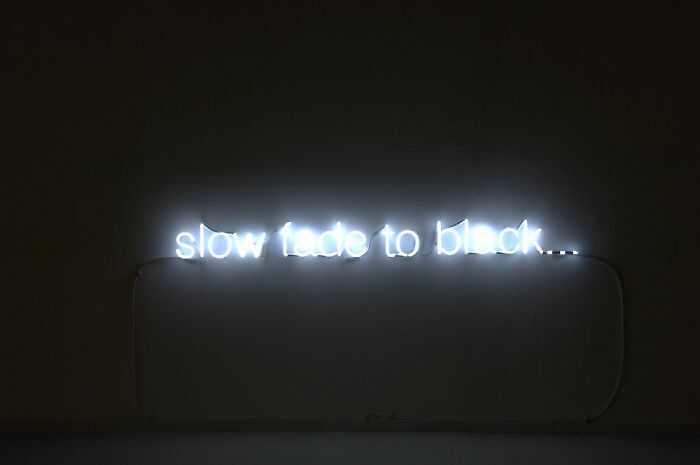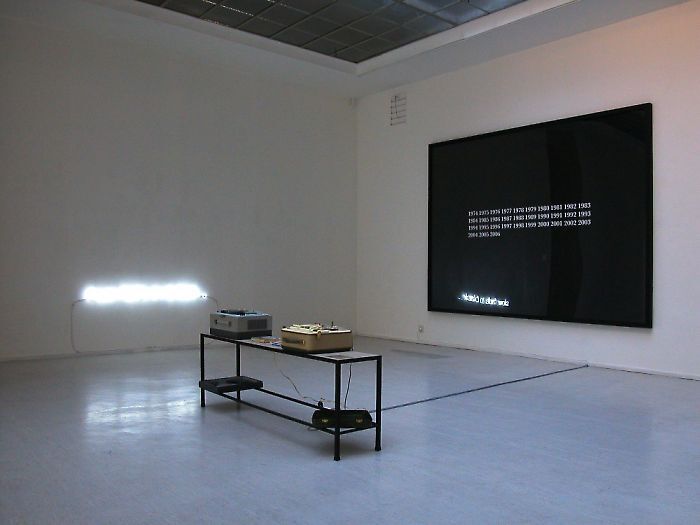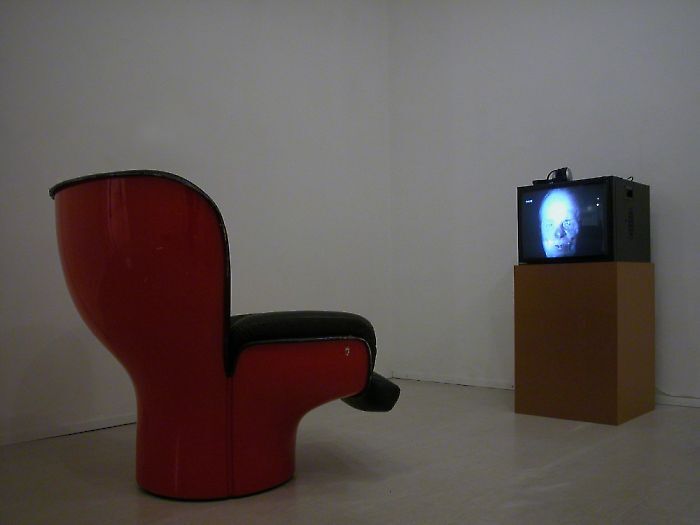—
Andreas Fogarasi
[scene missing]
Manon de Boer, Cerith Wyn Evans, Andreas Fogarasi, Björn Kämmerer, Theo Ligthart, Ján Mancuska, Christian Mayer, Wolfgang Plöger, Nadim Vardag, Marijke van Warmerdam, Christoph Weber
The exhibition [scene missing] groups eleven recent artistic positions that engage with cinema and film. Without showing film in the usual sense or simulating cinematic situations, the works presented here all interrogate methods of narrative construction and point out the fragmentary character of reality and its filmic representation. The absence of cinema and film at the exhibition [scene missing] is a product of our collective film memory. The receiver completes "the scene missing” by taking recourse to his or her own memories of cinema and film history. In the field of tension between the black box and the white cube, the cinema becomes a material in the works exhibited.
In contrast to avant-garde film and the expanded cinema, the motivation behind this artistic practice is not breaking with standard conventions, but rather the appropriation of such conventions. The conventions of filmic representation provide a starting point. Narrative structures, an interest in the mechanics of the projection apparatus, cinematographic traditions and the reception of film are all subjected to deconstruction and recoding. Film history becomes raw material.
Björn Kämmerer, Marijke van Warmerdam, Manon de Boer and Christoph Weber share a common interest. They make use of antiquated technology, forcing onto film projectors or old tape players functions for which they were not intended. The mechanical apparatus is staged as fetish.
In his 35mm film loop escalator (2006), the German artist Björn Kämmerer shows a boy dressed in coat and tie walking up and down a stairway, apparently endlessly. The linear narrative structure and spatial orientation is suspended by the editing and reflection and generates a disturbing sense of infinitude.
The 16mm film loop Passage (1992) by the Dutch artist Marijke van Warmerdam shows a black small square that slowly emerges from the middle of a white backdrop to fill the entire projection surface; after the process has completed, it then starts again. This perpetual motion engenders associations in the spectator that can allow stories to develop. As the artist puts it, “Passage is a work which troubles my eye and my thoughts. I have the feeling that the phenomenon film has been stripped to the bone, but still someone is pulling my leg. In the meantime, my eye is very much attracted by its movements in black and white. It could be a tunnel, it could be an elevator, it could be the beginning of a story. In fact, it is no more than what it is. Or isn't it?"
Nadim Vardag explores the construction of mediated images and questions the mechanisms of cinema and film production using quite diverse media: sculpture, drawing, and film. In the work The Night (2005) Vardag uses the subtitles from the Antonioni film of the same name. The absence of image and sound places the focus on the written dialogue. The screenplay seems to return as the starting point for making a film, serving as material for the viewer to imagine a film of his or her own: beholder becomes director. Similarly, Black Screen (2007) challenges us to fill the void black screen with our own individual projections. This sculptural work represents the mimetic depiction of a surface of projection: dysfunctional due to its being black, it remains empty and imageless. At the same time, the work also recalls minimalist sculpture and functions as a projection surface for our own cinema memories.
In this work Avant-Garde (Rainer, Kubelka, Ligthart) (2002) Theo Ligthart analyzes an icon of avant-garde film: Peter Kubelka's film Arnulf Rainer (1960). Rainer had commissioned Kubelka to produce a documentary on his artistic work; to Rainer’s surprise, Kubelka then presented him with a film consisting exclusively of white and black squares in a rhythmic sequence that was subject to a strict score. Ligthart translates this score in his work Avant-Garde (Rainer, Kubelka, Ligthart) to a rhythm of light and dark by synchronizing the supply of electricity supply for a light source according to the score of Kubelka’s film, using a small box with a processor to control the flow of electricity. This box can be attached to any random light source, allowing any living room to be transformed into an avant-garde cinema. His work Spielfilm (Director’s Cut) (2002-2004) shown in the gallery skylight hall is formally based on the visual language of avant-garde film. The break with filmic narration in experimental cinema is here taken to its absurd limit; plots from mainstream cinema are all combined into a single sentence and presented in a formal reproduction of a cinema advertising case, thus referring to the aesthetic of film stills as shown in such displays in Central Europe. The result is a sequence of text images that displays the redundancy of the standard narrative cinema in an ironic way and directly inspires the individual film memory of the receiver.
In end (2007) and 1974, 1975, 1976... (2007), Andreas Fogarasi presents monumental silk screens of the intertitles from his video installation Kultur und Freizeit (2006), which was on view at the last Venice Biennale. The size of the works corresponds to the projection surface of his video. The film deals with cultural and educational institutions in Budapest, their architecture and the change in programming and questions about the aesthetic and structural notions of their builders and users. The intertitles, which originally point to the former and current realities of architectures presented, are extracted from the videos. Now robbed of their context, they become projection surfaces for individual memories.
In his installation untitled (one, two flags) (2008), the German artist Wolfgang Plöger shows two slide projections of rooftop landscapes; between the two he has placed a flag being blown by a fan. The static projections are animated by the moving shadow of the flattering flag; the motionless image seems to become cinematic. Shadow theater fuses with realistic photography, forming a poetic installation. The link of the real, present object of the flag and the unreal roof landscape pose the question of the representation of reality by the cinematographic apparatus and the perception of reality linked to it.
The installation Sorry Being So Late (2007) by Czech artist Ján Mancuska is based on photographs taken in Prague’s largest park, just near the artist’s home. Over the map of the park, he placed a grid, and walked from sunrise to sunset from one of the sixty-four points on the grid to another, shooting photographs from each point of intersection. Thus, each roll of film hanging from the ceiling marks a grid point and the perspectives of the park that can be seen from there. The work documents the entire area of the park and its change in daylight. Presented in front of an oversized light box, the beholder can take up the spatial as well as temporal sequence of the park and the course of the day, but in a fully different space and time relationship. By choosing the points of intersection as a camera position, the entire landscape seems to be documented, but these very points of intersection become the blind spots in the park’s documentation. The hanging rolls of film stand for the lack of depictions of the sites from which the park was photographed.
In Christoph Weber’s work Telefunken und Tesla (2007) two tape recorders from the late 1950s (a West German Telefunken and a Czechoslovakian Tesla) — enter into an apparent dialogue with one another. The machines play back fragments of a text compiled of fragments from German versions of various science fiction films from the 1950s to today. They enter into a fictive dialogue that represents in an emotionally dramatic fashion the scientifically charged propaganda battles of the Cold War in a television spaceship. By contrasting two devices from the early days of home recording, the artist refers to a time when the propaganda battle between east and west was at its climax and found its way into household archives through such media.
Since the early 1990s, Welsh artist Cerith Wyn Evans has been combining multilayered references from literature, poetry, philosophy, film theory, and the modern natural sciences with formal allusions to the conceptual models of the art work from the 1960s and 1970s in his work. In expansive installations—light writing on walls, film projections, and sculptural objects—Wyn Evans thus evokes an aesthetic cosmos in which the unending process of subjective and associative perception takes the place of clarity and transparency in conveying information. The work exhibited here slow fade to black… (reversed) (2004) comes from the artist’s Subtitle Series. The spatial placement of the neon lighting close to the floor transforms the gallery’s white wall into a film-like image. But the content of the sentence contrasts with the garish neon light and bright walls; slow fade to black suggests the slow disappearance of the image, whereby this expectation is constantly disappointed.
For the Indian born artist Manon de Boer, history is not a linear series of events but the experience of a constant process in which selective memories are set in relation to one another in a very particular way. Using the personal story as a narrative method, Boer explores the relationship between language, time, and the claim to truth in her work. The “narrative history” of key figures from various contexts, like Sylvia Kristel, who achieved some fame as the actress Emanuelle, allows the artist to explore concepts of memory and conviction and the coincidence of lived and written history in general. Sylvia, March 1&2, 2001 Hollywood Hills (2001) shows a close up of Sylvia Kristel looking into the camera and smoking. The rattling sound of the 16mm projector becomes the sound track of the silent dialogue between the figure represented and the artist. The tradition of portraiture is thus linked to individual filmic memory.
Christian Mayer’s film Sherlock Jr. (Buster Keaton, 1924) will be shown as a film supporting the regular program at Top Kino in the framework of the exhibition [scene missing]—a supporting film that does entirely without images. In this film, a scene from the Buster Keaton film Sherlock Jr. is described in the fashion of the running commentary that is provided for the blind or vision-impaired. While the film projector only projects white light on the screen, a voice describes how Keaton springs through a cinema screen into a film, where as an active figure he tumbles into a whole series of calamities, for he refuses to understand the discontinuity of time and space in film. By replacing the original filmic image with an oral narrative, this sound film expands the complex architecture of Keaton’s film into the viewing space. The narrative places the story directly in our imagination and allows us to imagine a space where fiction and reality can no longer be distinguished from one another.
Text / Curator: Fiona Liewehr
Biography
1977 born in Vienna, lives and works in Vienna
Selected Solo Exhibitions
2025
City of Glass, tranzit.ro/Cluj, Romania
Weinstadt, Bierstadt, Wasserstadt, Lombardi—Kargl, Vienna
Cittá d'Acciaio, Galleria Massimo Ligreggi, Catania
2024
Cities, Gandy Gallery, Bratislava
2023
Figur, Kunstfenster Gnas, Gnas
Kyiv, Brussels, Budapest, Vintage Galéria, Budapest
Last Minutes, Kunsthaus Muerz, Mürzzuschlag (wit Markéta Othová)
Letting Do, Torula Artspace, Györ (with Adrienn Kiss)
1978, QUARTZ STUDIO, Turin
2028, vai - Vorarlberger Architektur Institut, Dornbirn
2022
Skin Calender, Budapest Gallery, Budapest
Five Ways of Telling Time, Georg Kargl Fine Arts, Vienna (with Mariana Castillo Deball)
2021
Up and Down, Vi Per Gallery, Prague
2020
MI, Vintage Galérie, Budapest (with Christian Kosmas Mayer)
2019
Nine Buildings, Stripped, Kunsthalle Wien, Vienna
Work, Galería Casado Santapau, Madrid
Vasarely Go Home, Galerie Florence Loewy, Paris
Kultur und Freizeit, Per Albin, Vienna (with Christoph Ruckhäberle)
2018
Production, FL Gallery, Milan
Kettő / Two, Vintage Galéria, Budapest
Monuments offerts, Galerie Thomas Bernard / Cortex Athletico, Paris
Black Concrete, Kunstforum Montafon, Schruns (with Martina Steckholzer)
2017
Culture and Free Time, Csili Cultural Center, Budapest
Exhibition/s, Georg Kargl Fine Arts, Vienna
Plan, Galéria mesta Bratislavy/Bratislava City Gallery, Bratislava
Copy, Kunstbuero, Vienna
2016
Sculpture, Proyectos Monclova, Mexico City
Book Launch, LAMOA - Los Angeles Museum of Art, Los Angeles
Modelle, Jesuitenfoyer, Vienna
2015
Installation, Tranzit, Iași (Rumania)
Video, Galería Casado Santapau, Madrid
Photography, amt _ project, Bratislava
Tracks and Traces, City Museum, Belgrade (with Sasa Tkacenko)
2014
Black Earth, MAK Center for Art and Architecture, Los Angeles (mit Oscar Tuazon)
Vasarely Go Home, GFZK – Museum of Contemporary Art, Leipzig
Vasarely Go Home, Museum Haus Konstruktiv, Zurich
1988, Galeria Vermelho, São Paulo
2013
Année Le Nôtre, Galerie Cortex Athletico, Paris
Kiosk (Buda), Park Galéria, Budapest
Kiosk (Buda), Georg Kargl Permanent, Viennaa
2012
2018, Prefix Institute of Contemporary Art, Toronto
180°, Neuer Kunstverein Wien, Vienna (with Mladen Bizumic)
Vasarely Go Home, Trafó, Budapest
Vasarely Go Home, Galerie Cortex Athletico, Bordeaux
Épitészet / Architecture, Liget Galéria, Budapest
Headlines and Small Print, Galerija Nova, Zagreb (with Maryam Jafri)
2011
La Ciudad de Color / Vasarely Go Home, Museo Nacional Centro de Arte Reina Sofia, Madrid
Constructing / Dismantling, Centro Andaluz de Arte Contemporáneo, Sevilla
Solo presentation, Galerie Cortex Athletico, Armory Show, New York
2010
Georgetown, Georg Kargl Fine Arts, Vienna
1998, Ludwig Forum für Internationale Kunst, Aachen
2008
Fairview, Lombard-Freid Projects, New York
Support Surface, Galerie Cortex Athletico, Bordeaux
2008, MAK, Vienna
Információ, Ernst Museum, Budapest
Kultur und Freizeit, Grazer Kunstverein, Graz
2007
Kultur und Freizeit, Hungarian Pavilion, 52. Biennale di Venezia, Venice
2006
Norden, Georg Kargl Box, Vienna
2005
Westen (aka Osten), Grazer Kunstverein, Graz
Süden, Porschehof/Salzburger Kunstverein, Salzburg
2004
A ist der Name für ein Modell / Étrangement proche, Liget Galéria, Budapest
2003
ABCity (The Player), Trafó, Budapest (curator)
Welcome to Regions, Display Gallery, Prague
A ist der Name für ein Modell / Étrangement proche, Offspace, Vienna
2002
Kultúrapark, Stúdió Galéria, Budapest
Culture Park, Galerie 5020, Salzburg
1999
Modell Ambient (Bunte Laune), Transit VZW, Mechelen
Selected Group Exhibitions
2025
Il Cerchio Schiacciato – nel tempo della Globalizzazione e degli Equilibri Instabili, Fondazione Mudima, Milan
Zwischen Stufen, Phasen, Stopps (TUN FÜR TUN), Kunstverein Eisenstadt, Eisenstadt
Between Spheres,Art and Science – Works from the Collection of the Central Bank of Hungary (MNB), Várkert Bazár – Ybl6 Art Space, Budapest
2024
Clubs der Zukunft | Clubs of the future, Kunstverein am Rosa-Luxemburg-Platz, Berlin
Loose Ends, Modest Common, Los Angeles
Täterätää! Back with a Bang! KEX Reopens, Kunsthalle Exnergasse, Vienna
2023
Handle with Care, Ludwig Museum, Budapest
Coincidence of Wants, Wien Museum MUSA, Vienna
Humans and Demons, Steirischer Herbst, Graz
Schau...9, Kunsthaus Kollitsch, Klagenfurt
Here and Now II - Vienna Sculpture 2022, Neuer Kunstverein Wien, Vienna
Wir legen alles Geld zusammen, Kunstverein Schattendorf, Schattendorf
Verzweigt. Bäume in Fotografien der Sammlung SpallArt, Städtische Galerie Rosenheim, Rosenheim
Spectacular City, Holocaust Memorial Center, Budapest
2022
On/Off the Grid, Jecza Gallery, Timisoara
Wiener Freiheit, Galerie 3, Klagenfurt
I Had a Dog and a Cat, curated by Hana Ostan Ozbolt, Georg Kargl Fine Arts, Vienna
Lost in Space, Raum, Ding und Figur – Entwicklungen innerhalb der Skulptur seit 1945, Museum Liaunig, Neuhaus/Suha
2021
CELOK JE MENŠÍ AKO SÚČET JEHO ČASTÍ, City Gallery Bratislava, Bratislava
Mäusebunker & Hygieneinstitut. Experimental Setup BERLIN Architetture di G+M Hänska I Fehling + Gogel, Sala Espositivo Gino Valle, Venice
Haus Wien, Vienna
Zwischen den Dingen, Volkskundemuseum, Vienna
PROSTESTFormen, www.paraflows.at (online)
Frech und Frei, MAK - Museum für Angewandte Kunst Wien, Vienna
SHOWING STYRIA: what will be. Towards the Plurality of Futures, STEIERMARKSCHAU / Kunst Haus Graz, Graz
2020
Would You Be Available…, Georg Kargl Permanent, Vienna
Gallery for Peace, Umetnostna galerija Maribor
Trafó Galéria, Budapest
2019
40.000 Ein Museum der Neugier, 14. Fellbach Triennale, Fellbach
Im Raum die Zeit lesen, MUMOK, Vienna
Iparterv 50+, Ludwig Museum, Budapest
Presencia lúcida, Colección ESPAC, Mexico City
Hommage à 1969, Vasarely Museum, Budapest
Panel, MODEM, Debrecen
Textus Ex Machina, aqb Project Space, Budapest
2018
para inglês ver, Post Ford Palace, Porto
Into the City, Museum Moderner Kunst Kärnten, Klagenfurt
Universe of Relations, ZARYA Center for Contemporary Art, Vladivostok
Seeing artists voices, Metro, Porto
Stúdió’18 - Szalon, Hungarian University of Fine Arts, Budapest
Reduction, Georg Kargl Fine Arts, Vienna
Ist Eros der eben jetzt von mir beobachtete Planet?, Kunstverein am Rosa-Luxemburg-Platz, Berlin
2017
Wanderings, Galeria Cristina Guerra, Lisbon
Traces of Time, Leopold Museum, Vienna
OFF Biennale, Budapest
Gazdálkodj okosan! / Economize!, Ludwig Museum, Budapest
Ice Floe – The institutional issue, National Museum for the Visual Arts, Montevideo
Abstract Hungary, Künstlerhaus Halle für Kunst & Medien, Graz
10 years old, Fondazione Fotografia Modena, Modena
Save As... – What Will Remain of New Media Art?, Ludwig Museum, Budapest
LAMOA presents: Mülheim/Ruhr und die 1970er-Jahre, Kunstmuseum Mülheim an der Ruhr
moi non moi, Wiener Art Foundation in Athens, Athens
2016
The Errors of Beauty, National Gallery, Sofia
The Language of Things – Material Hi/Stories from the Collection, 21er Haus, Vienna
Grenzen der Geste, Galerie der Hochschule für Grafik und Buchkunst, Leipzig
The Past is the Past, Galerie Thomas Bernard / Cortex Athletico, Paris
Cartography of Artist Solidarity, tranzit.hu, Budapest
Art Capital, Müvészet Malom, Szentendre (Hungary)
2015
Destination Vienna, Kunsthalle Wien, Vienna
Nadezhda – The Hope Principle, special project for the 6th Moscow Biennial, Moskow
Wohin gehen wir? Videokunst zur Stadtgesellschaft, Motorenhalle, Dresden
Transparency, Georg Kargl Fine Arts, Vienna
Inside Out - Not So White Cube, Mestna Galerija, Ljubljana
Sector 17, Galerie Martin Janda, Vienna
[ ], Schwarzwaldallee, Basel
Close Up, etc. galerie, Prague
El Presente en el Pasado, Centro Andaluz de Arte Contemporáneo, Sevilla
Vienna Biennale – 24/7. the human condition, MAK, Vienna
Der Raum nach dem Raum, kunsthaus muerz, Mürzzuschlag
2014
I Know Not to Know, Georg Kargl Fine Arts, Vienna
El Teatro del Mundo, Museo Tamayo Arte Contemporáneo, Mexico City
Report on the Construction of a Spaceship Module, New Museum, New York
Turning Points, Hungarian National Gallery, Budapest
Notes from Underground, Baba Vasa’s Cellar, Shabla (Bulgaria)
Frisch eingetroffen – Neuankäufe Fotografie, Landesgalerie Linz des OÖ. Landesmuseums, Linz
Texte in der Kunst, Georg Kargl Fine Arts, Vienna
Urbane Perspektiven - Dark City, Schafhof - Europäisches Künstlerhaus Oberbayern, Freising
Interieurs, Landesgalerie Linz des OÖ. Landesmuseums, Linz
2013
Word+Work, Galerie nächst St. Stephan Rosemarie Schwarzwälder, Vienna
Jetztzeit (El tiempo del ahora), Centre d’Art la Panera, Lleida (Spain)
Modern Architecture Works, Vivacom Arthall, Sofia
Cinematic Scope, Georg Kargl Fine Arts, Vienna
De belles sculptures contemporaines – la collection du Frac des Pays de la Loire, Hab Galerie, Nantes
Conceptualism Today – Conceptual Art in Hungary since the beginning of the 1990s, Paksi Képtár, Paks
Die Sammlung 2 / The Collection 2, 21er Haus, Vienna
2012
Ça & Là / This & There, Fondation Ricard, Paris
Montag ist erst übermorgen, Akademie der bildenden Künste, Vienna
Gallery by Night, Stúdió Galéria, Budapest
Bleibende Werte? /Enduring Value?, Kunsthaus, Bregenz
Demnächst, Galerie 5020, Salzburg
Die Sammlung / The Collection, 21er Haus, Vienna
State of Affairs, amt _ project, Bratislava
2011
Erschaute Bauten / Envisioned Buildings, MAK, Vienna
Beziehungsarbeit, Künstlerhaus, Vienna
Monument Valley – Jaegerspris Revisited, UFO presents, Berlin
5x5 2011, Espai d´art contemporani de Castelló, Castelló (Spain)
Shift and Flow, Dorsky Gallery Curatorial Programs, New York
alter///scrinium – Ten Theses of Architecture, 9th International Film Festival, Vladivostok
In Between, Austria Contemporary, CAC, Vilnius
Magáért beszél, Hungarian National Gallery, Budapest
Where is my Place, Fondazione Bevilacqua La Masa, Venice
Passion of an Ornithologist. On Myth Making, BWA Sokol, Nowy Sacz (Poland)
NeoSI #2: neue Situationistische Inter......nationale, Kunstraum Schattendorf (Austria)
Public Folklore, Grazer Kunstverein, Graz
2010
Related Spaces, Ernst Museum, Budapest
There has been no Future, there will be no Past, ISCP, New York
Architecture and Context – Breuer in Pécs, Fuga – Budapest Center of Architecture, Budapest
La Ciudad Interpretada, Public Space/CGAC, Santiago de Compostela
Paisatge. Paisatge?, Angels Barcelona
Over the Counter, Mücsarnok, Budapest
Le présent du passé, FRAC des Pays de la Loire, Gétigné-Clisson
Unmistakable Sentences, Ludwig Museum, Budapest
Transitland, Space Gallery, Bratislava
Art Always has its Consequences, (former) Museum of Contemporary Art, Zagreb
Arrivals and Departures_Europe, Mole Vanvitelliana, Ancona
A Pair of Left Shoes, MSU – Museum of Contemporary Art, Zagreb
Fine Line, Georg Kargl Fine Arts, Vienna
2009
TypoPass, Labor, Budapest
History, Memory, Identity, Fondazione Cassa di Risparmio di Modena
BC 21 Art Award, Augarten Contemporary, Vienna
A Pair of Left Shoes, Kunstmuseum Bochum, Bochum
Új szerzemények – rég nem látott művek, Ludwig Museum, Budapest
Reduction&Suspense, Magazin4 – Bregenzer Kunstverein, Bregenz
El Pasado en el Presente, Laboral Centro de Arte, Gijon
Reading the City, ev+a Exhibition of Visual Art, Limerick
Fifty Fifty, Wien Museum Karlsplatz, Vienna
Figure/Ground, Transit, Mechelen
Rewind, Fast Forward – Video Art from the Collection, Neue Galerie, Graz
Expanded Box – Cinema, ARCO, Madrid
2008
Moirés, Kunstraum der Universität Lüneburg, Lüneburg
Colección Pecar. Atemporalidad, Museo de Arte Moderno y Contemporáneo, Santander
In Between, Austria Contemporary, Genia Schreiber University Art Gallery, Tel Aviv
Modern Ruin, Queensland Art Gallery / Gallery of Modern Art, Brisbane
6th International Biennale, Gyumri (Armenia)
Art Unlimited, Art 39 Basel
50, Studio Galeria, Budapest
Islands+Ghettos, Heidelberger Kunstverein
Scene Missing, Georg Kargl Fine Arts, Vienna
Scene Missing, Galerie Thomas Schulte, Berlin
Phantasies of the Beginning, Billboard Gallery, Bratislava
Undiszipliniert, Kunsthalle Exnergasse, Vienna
Am Puls der Stadt – 2000 Jahre Karlsplatz, Wien Museum Karlsplatz, Vienna
2007
Cine y casi cine, Centro de Arte Reina Sofia, Madrid
Kapitaler Glanz, Kunstverein für die Rheinlande und Westfalen, Düsseldorf
Models for Tomorrow: Cologne, European Kunsthalle, Cologne
2006
This Land is my Land, NGBK, Berlin
Center, MAK Center, Los Angeles
wood, photographs, aluminium plate, LED, table, book, silkscreen, personal computer, monitor, web connection, nivea cream, video, paper, graphite, pencil, acrylic, Galerie Jocelyn Wolff, Paris
How to do Things?, Kunstraum Kreuzberg / Bethanien, Berlin
This Land is my Land, Kunsthalle Nürnberg, Nuremberg
Der Raum zwischen zwei Bildern, Fotohof, Salzburg
Geschichte(n) vor Ort, Volkertviertel, Vienna
How to do Things?, Trafó, Budapest
2005
Re:Modern, Künstlerhaus, Vienna
Brutal Ornamental, Galerie Kosak Hall, Vienna
Reading in Absence, Trafó, Budapest
Utopie : Freiheit, Kunsthalle Exnergasse, Vienna
Alice Creischer/Andreas Siekmann, Andreas Fogarasi, Dorit Margreiter, Kunstraum Lakeside, Klagenfurt (permanent)
Storyboards – Trapped in the escape, Vector Gallery, Iași (Rumania)
citysellingcitytelling, Sparwasser HQ, Berlin
2004
Images of Violence/Violence of Images, Biennale of Young Artists, Bucharest
Living Room, Kunsthalle Exnergasse, Vienna
Wiener Linien, Wien Museum Karlsplatz, Vienna
Video as Urban Condition, Austrian Cultural Forum, London
Formate – (re-)constructing the city, Galeria Noua, Bukarest
2003
Gegeben sind... Konstruktion und Situation, Galerie im Taxispalais, Innsbruck
Balkan Konsulat proudly presents: Budapest, Rotor, Graz
GNS, Palais de Tokyo, Paris
Gravitation, Moszkva tér, Budapest
Grosser Sommer an der Thaya, Drosendorf
2002
Site-Seeing: Disneyfication of Cities?, Künstlerhaus, Vienna
Evidence, Essor Gallery Project Space, London
Manifesta 4, Frankfurter Kunstverein, Frankfurt/Main
Double Bind, ATA Center for Contemporary Art, Sofia
Gallery by Night, Stúdió Galéria, Budapest
2001
Szerviz, Mücsarnok/Kunsthalle, Budapest
Real presence, Studentski Kulturni Centar, Belgrade
A table, an office, a building..., Semperdepot, Vienna
January Show, Passagegalerie Künstlerhaus, Vienna
2000
block, Apex Art, New York
99/00, Semperdepot, Vienna
1998
Clarice Works, Zentnerstrasse 18, Munich
1997
Új stúdiósok, Duna Galéria, Budapest
1995
Odyssee today, University of Athens, Athens
Odyssee today, Depot, Vienna
Inquiry
Please leave your message below.
